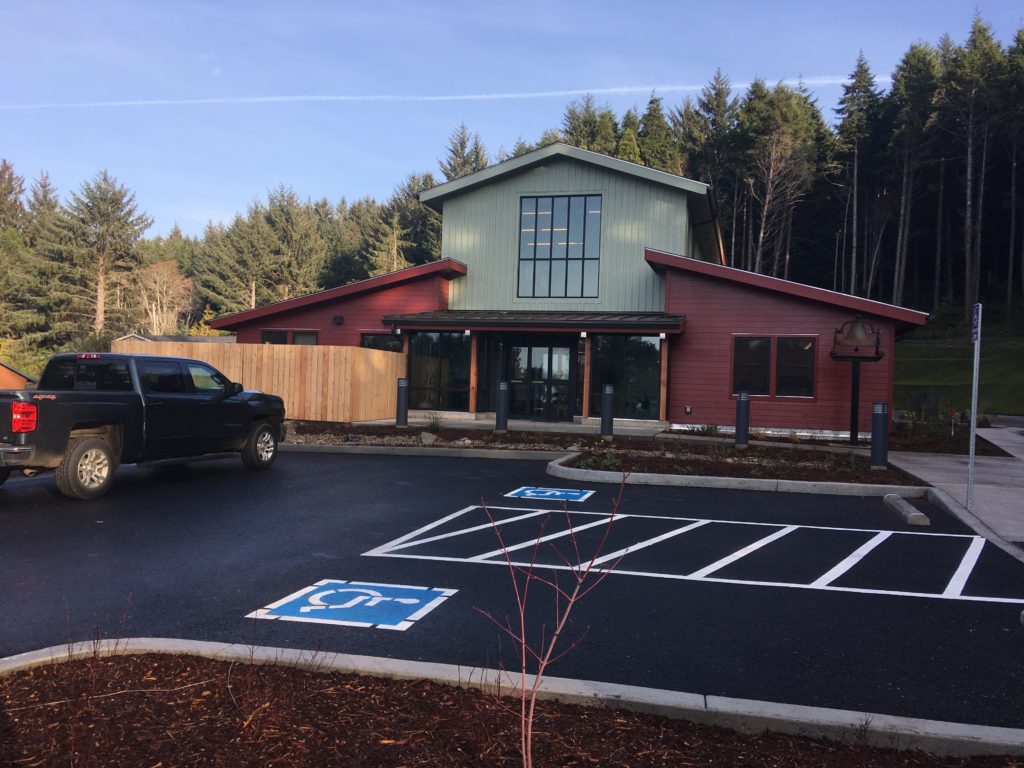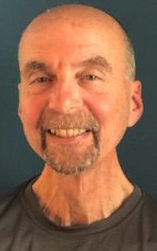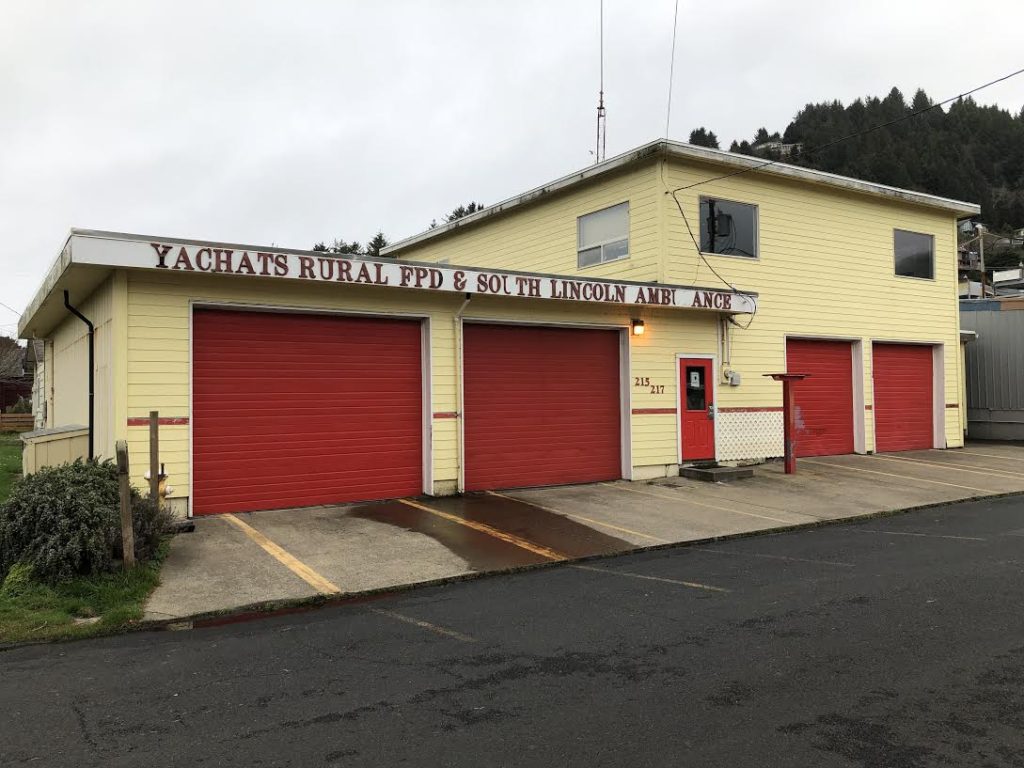
By QUINTON SMITH/YachatsNews
The Yachats Rural Fire Protection District is again using a bank loan to pay its monthly bills as it looks both to cut spending and seek more money by asking voters to raise their taxes.
The district has taken out a bank loan each of the last four years to help make ends meet, paying it off by Dec. 31 before taking out a new line of credit within months.
The district took out a new line of credit of $550,000 in February, again using its Yachats River station as collateral. It drew $76,000 from that at the end of February to help pay its bills.
But the calendar-year loans often spill over to the next fiscal year, which begin each July. That means the district has to use new operating money it receives from property taxes in November to pay off the old loans before the end of each year.
It is legal for a government agency to take out loans to cover operating costs in anticipation of an influx of property taxes in the fall. But, in the fire district’s case, it is costing them up to $25,000 a year on the loan’s 5.25 percent interest. It also indicates the district has not been able to balance flat revenue with increased operating costs.
The shortage of funds in the fire district’s $1.395 million yearly budget is due to several factors:
- It was forced to use $125,000 out of its operating funds in 2018-2019 to repay interest it taken out of a savings account where it had co-mingled money from two property tax levies and a $7.7 million bond passed by voters in 2016.
- It spent $423,000 out of yearly operating funds – $85,000 to $95,000 a year for five years – to buy land for the new fire station, instead of using bond proceeds as is usually done elsewhere. The last of monthly payments were made only recently. Board members now admit using operating funds to buy the land was a mistake.
- Two property tax levies that fund much of the district’s operations, which have been renewed by voters every three years, have not been increased since they were first approved in 1999 and 2008.
- While income has remained flat, costs – everything from employee wages, to insurance, to the increased cost of operating the new station – have risen.

The district’s financial struggles came into clearer view to board members late last year when its newest member, Drew Tracy, began pushing to hire at least two more firefighter/paramedics and replace a 40-year-old engine. Only when Tracy proposed that the district ask voters for a third tax levy was the board fully informed how far it had fallen behind financially.
“Is this something new? How did we get here?” Betty Johnson, who has been on the board for 12 years, asked in February.
“It kind of snuck up on us,” replied Ed Hallahan, the longest serving member of the five-member board.
In addition to discussing finances at its last three monthly meetings, the board held a special meeting Feb. 22 to try to get a better handle on finances. Its next meeting is 10:30 a.m. Monday.
Board members have also been meeting in pairs with fire district administrators Frankie Petrick and Shelby Knife to try to more clearly understand the issues.
But no one has mapped out clearly in one document or meeting how the district ran into financial issues, how much it needs to stabilize itself, and what it needs to do for the future.
“I need a much better picture now of our fixed expenses before trying to consider an increase in the local option levy,” board chair Katherine Guenther said near the end of its last meeting. “I need a much better idea of what our shortfall is.”
Suggested cost-cutting moves
To save money, Petrick has suggested a series of cost-cutting measures, including:
- Having her and/or Knife be furloughed 1-4 days a month;
- Freeze employee salary increases, other than cost of living increases, until 2023;
- Pay only interest, instead of principal and interest, on an bank loan it has on one of its engines;
- Reduce overtime as much as possible;
- And, increase contributions to the district from South Lincoln Ambulance, which is an outside nonprofit but staffed by fire district employees.

The board has yet to approve any of Petrick’s suggestions; one saying that furloughs and wage freezes are demoralizing to employees.
The board is hoping the sale of its former station in downtown Yachats can provide enough money to allow it to stop taking out loans until it can ask voters to approve a new, higher operating levy in 2022. But getting a zone change from the city and having the property appraised has taken more than a year. And, it still doesn’t have a Realtor to market it.
“That money can get us to a stable point to plan … so we don’t work from a deficit every year,” said Tracy. “We can’t cut services.”
Guenther said although the sale of the old station “is a one-shot deal,” hopefully the proceeds will come close to what the district spent out of operating funds for the new station’s land purchase.
“That shortage ($423,000) can be replaced by the sale of the station,” she said.

Station sale and increased levy?
In addition to sale of its old station, the only other recourse the district’s board has to raise more revenue is to ask voters to increase the amount of one of its two operating levies. The district’s yearly operating budget comes from a permanent tax base and two voter-approved levies. Here’s how the levies work:
- The district’s permanent tax base, established in 1997, is 29 cents per $1,000 assessed property value;
- A three-year levy that started in 1999 carries a tax rate of 61 cents per $1,000 of assessed property value; it was last renewed in 2019 by a 3-to-1 vote ratio;
- A three-year levy that started in 2008 is 59 cents per $1,000; it was last approved in May 2018 by a 3-to-1 vote margin;
- In total, the three levies add up to a tax rate of $1.49 per $1,000 assessed property value or $372 a year on property assessed at $250,000.
Tracy had proposed a third, three-year levy to fund 2.5 new firefighter/paramedics and pay for a new engine. That met with resistance from three longtime board members who were reluctant to have voters decide an operating levy every year.
It was better, they argued, to increase the 59 cent levy to cover current operating costs, add personnel, and establish a reserve fund for new equipment.
“In 12 years we’ve never increased the amount we levy,” said Hallahan.
The downside of that, Hallahan said, is that the next levy won’t reach the ballot until May 2022 and – if approved by voters – wouldn’t generate more revenue until November 2023.
“We will still not have the money to do the things we want to do for 24 months,” said Hallahan, referring to filling the budget gap, hiring more people, and covering the costs of new equipment. “But the goal would be to come up with a number that allows us to do all those things.”
And that’s where the board is stuck. It hopes to come up a better picture of district finances over the next several months, get the old station on the market, and then decide what amount of money it needs in the future.
“Right now we have a deficit,” said Tracy. “We have to have a conversation on what to do for the next 24 months … and to have a game plan for the next three to four to five years.”



Well building a multi million dollar station in the forest in a community of 800 residents, while not having protection up the Yachats River has not been fiscally wise at all. Maybe they can make extra money renting out their upstairs area to vacation renters.